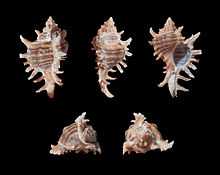Chicoreus brevifrons
| West indian murex | |
|---|---|
 | |
| A shell of Margarita Island, Chicoreus brevifrons | |
| Scientific classification | |
| Kingdom: | Animalia |
| Phylum: | Mollusca |
| Class: | Gastropoda |
| (unranked): | clade Caenogastropoda clade Hypsogastropoda clade Neogastropoda |
| Superfamily: | Muricoidea |
| Family: | Muricidae |
| Subfamily: | Muricinae |
| Genus: | Chicoreus |
| Species: | C. brevifrons |
| Binomial name | |
| Chicoreus brevifrons (Lamarck, 1822) | |
| Synonyms[1] | |
| |
Chicoreus brevifrons, common name the West Indian murex, is a species of predatory sea snail, a marine gastropod mollusk in the family Muricidae, the murex snails. [1]
Shell description
The maximum shell length of this species is up to 150 mm.[2]
The shell of C. brevifrons is relatively elongate, and has a typical muricid outline. Three axial varices are present along its body whorl, and they are ornamented by characteristic expanded hollow spines. It also presents flat spiral cords in the interspaces of its surface. The anterior canal is well-developed,[2] akin to several other Muricidae snails.
Distribution
C. brevifrons occurs in the Western Central Atlantic, from the Caribbean, the Gulf of Mexico, the Antilles to Brazil.[2]
Ecology
Habitat
This sea snail dwells on mud flats in protected bays and lagoons. It is commonly found near oyster banks, as well as mangrove areas.[2]
Feeding
C. brevifrons is an active predator of other molluscs such as oysters and clams.[3]
Human uses
This sea snail is locally collected for food, and is consumed raw or boiled.[2] The shell is often sold as a souvenir in local markets.
References
- ↑ 1.0 1.1 Houart, R. (2011). Chicoreus brevifrons (Lamarck, 1822). Accessed through: World Register of Marine Species at http://www.marinespecies.org/aphia.php?p=taxdetails&id=558803 on 2011-06-25
- ↑ 2.0 2.1 2.2 2.3 2.4 Leal, J.H. (2002). Gastropods. p. 99-147. In: Carpenter, K.E. (ed.). The living marine resources of the Western Central Atlantic. Volume 1: Introduction, molluscs, crustaceans, hagfishes, sharks, batoid fishes, and chimaeras. FAO Species Identification Guide for Fishery Purposes and American Society of Ichthyologists and Herpetologists Special Publication No. 5. 1600p.
- ↑ Arcas, A.P. et al. (2001). Producción secundaria e índice de condición en Arca zebra (Mollusca: Bivalvia) del Golfo de Cariaco, Venezuela. Rev. Biol. Trop., 49(2): 599-608.
- Rosenberg, G., F. Moretzsohn, and E. F. García. 2009. Gastropoda (Mollusca) of the Gulf of Mexico, Pp. 579–699 in Felder, D.L. and D.K. Camp (eds.), Gulf of Mexico–Origins, Waters, and Biota. Biodiversity. Texas A&M Press, College Station, Texas.
- Merle D., Garrigues B. & Pointier J.-P. (2011) Fossil and Recent Muricidae of the world. Part Muricinae. Hackenheim: Conchbooks. 648 pp. page(s): 104
| Wikimedia Commons has media related to Chicoreus brevifrons. |
External links
| Wikispecies has information related to: Chicoreus brevifrons |